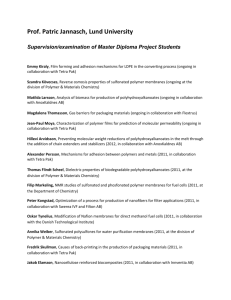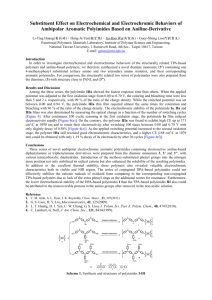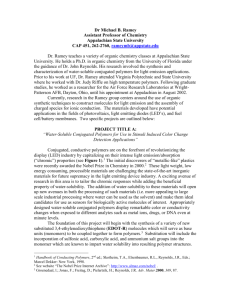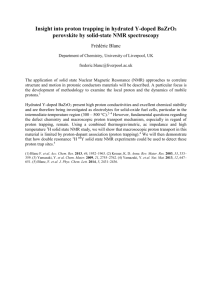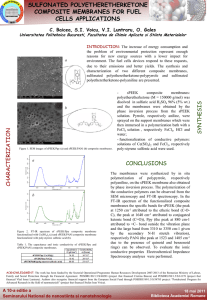Phosphorus-Containing Sulfonated Polyimides for Proton Exchange
advertisement
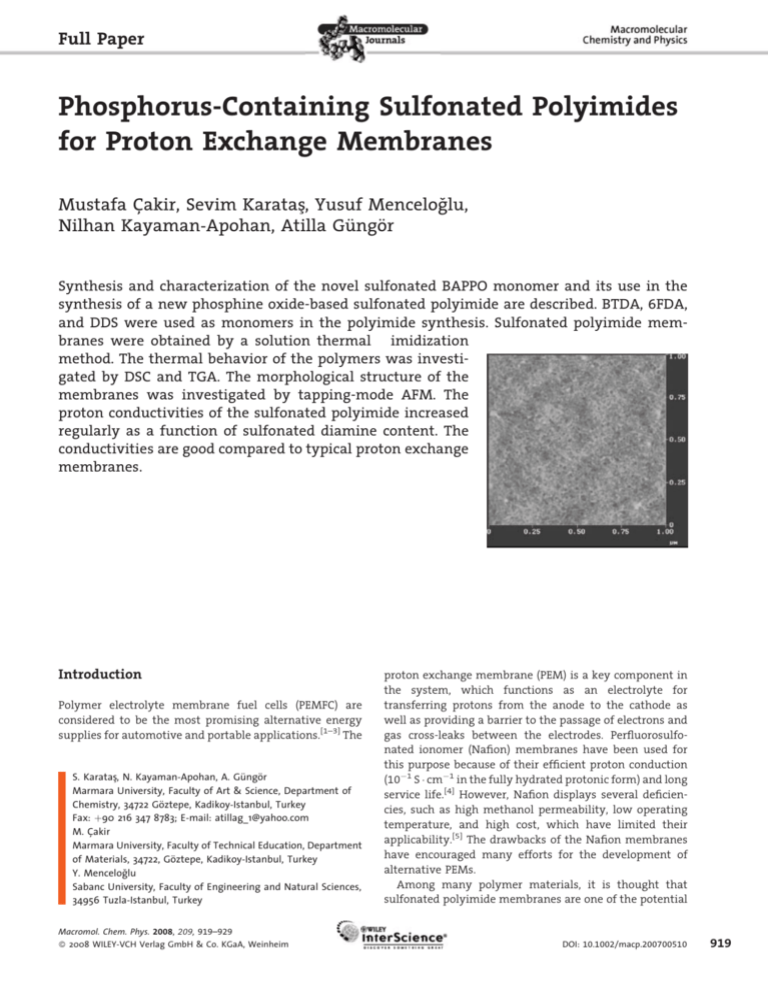
Full Paper Phosphorus-Containing Sulfonated Polyimides for Proton Exchange Membranes Mustafa Çakir, Sevim Karataş, Yusuf Menceloǧlu, Nilhan Kayaman-Apohan, Atilla Güngör Synthesis and characterization of the novel sulfonated BAPPO monomer and its use in the synthesis of a new phosphine oxide-based sulfonated polyimide are described. BTDA, 6FDA, and DDS were used as monomers in the polyimide synthesis. Sulfonated polyimide membranes were obtained by a solution thermal imidization method. The thermal behavior of the polymers was investigated by DSC and TGA. The morphological structure of the membranes was investigated by tapping-mode AFM. The proton conductivities of the sulfonated polyimide increased regularly as a function of sulfonated diamine content. The conductivities are good compared to typical proton exchange membranes. Introduction Polymer electrolyte membrane fuel cells (PEMFC) are considered to be the most promising alternative energy supplies for automotive and portable applications.[1–3] The S. Karataş, N. Kayaman-Apohan, A. Güngör Marmara University, Faculty of Art & Science, Department of Chemistry, 34722 Göztepe, Kadikoy-Istanbul, Turkey Fax: þ90 216 347 8783; E-mail: atillag_1@yahoo.com M. Çakir Marmara University, Faculty of Technical Education, Department of Materials, 34722, Göztepe, Kadikoy-Istanbul, Turkey Y. Menceloǧlu Sabanc University, Faculty of Engineering and Natural Sciences, 34956 Tuzla-Istanbul, Turkey Macromol. Chem. Phys. 2008, 209, 919–929 ß 2008 WILEY-VCH Verlag GmbH & Co. KGaA, Weinheim proton exchange membrane (PEM) is a key component in the system, which functions as an electrolyte for transferring protons from the anode to the cathode as well as providing a barrier to the passage of electrons and gas cross-leaks between the electrodes. Perfluorosulfonated ionomer (Nafion) membranes have been used for this purpose because of their efficient proton conduction (101 S cm1 in the fully hydrated protonic form) and long service life.[4] However, Nafion displays several deficiencies, such as high methanol permeability, low operating temperature, and high cost, which have limited their applicability.[5] The drawbacks of the Nafion membranes have encouraged many efforts for the development of alternative PEMs. Among many polymer materials, it is thought that sulfonated polyimide membranes are one of the potential DOI: 10.1002/macp.200700510 919 M. Çakir, S. Karataş, Y. Menceloǧlu, N. Kayaman-Apohan, A. Güngör candidates, because they have excellent thermal stability and mechanical durability, low methanol permeability as well as excellent film-forming ability. They are also reported to display a high proton conductivity, comparable to Nafion.[6] The first sulfonated polyimides, which are called phthalic polyimides, were synthesized from 4,40 -diamino-biphenyl 2,20 -disulfonic acid, 4,40 -oxydianiline, and oxy-diphthalic dianhydride.[7,8] Unfortunately, the studies showed that these polymers were not very stable under fuel cell working conditions. As a second generation, sulfonated polyimides derived from bis(naphthalenic dianhydride) demonstrated improved performance as a proton exchange membrane. However, they also have some disadvantages such as poor solubility and low processability in commercially available solvents. Therefore, much effort has been spent on synthesizing processable, tractable polyimides without compromising desired properties. It has been proven that the phenylphosphine oxide moiety provides a strong interacting site for imparting miscibility with several systems.[9–11] Phosphine oxidecontaining polymers display excellent adhesion properties.[12] Recently, the synthesis of a phosphine oxide-bearing amine-end capped arylene ether oligomer has been reported as a precursor for polyimides.[13] High-molecularweight sulfonated polyimide was prepared and thermal characterization demonstrated that the material is thermally stable up to 480 8C. It was also reported that polyimides prepared from novel diamine-containing fluorine and phosphine oxide exhibit excellent solubility and good thermal stability.[14] This paper describes the synthesis and characterization of a new sulfonated bis(mamino phenyl) phenyl phosphine oxide monomer and its utilization in the preparation of homo- and co-polyimides. Their physical properties, water uptake, ion exchange capacity, and proton conductivity are also investigated. Characterization Methods FT-IR spectra were recorded on a Shimadzu 8303 FT-IR spectrometer in order to confirm the distinct functional groups within the monomers and the polymers. 1H and 31P NMR spectroscopy and mass spectrometry were also used to obtain further structural information for evaluation of the monomer synthesized. NMR spectra were recorded using a Varian Model T-60 NMR spectrometer operated at 200 MHz. GC-MS analyses were obtained using a Thermo Finnigan Trace GC Ultra and Thermo DSQ. Thermogravimetric analyses (TGA) of polymers were performed using a TA Instruments Q50 model TGA. Samples were run from 30 to 800 8C at a heating rate 10 8C min1 under nitrogen atmosphere. Differential scanning calorimetry (DSC) analyses of the polymer were performed using a Perkin Elmer DSC Pyris Diamond model. Samples were run under a nitrogen atmosphere from 50 to 220 8C with a heating rate of 10 8C min1. Atomic force microscopy (AFM) images were taken in tapping mode using a Veeko Metrology Group, Nanoscope IIIa Multimode instrument. The ion-exchange capacity (IEC) was determined by a classical titration method. The swelling experiment in water was carried out by measuring the uptake of water at room temperature. Previously dried and weighed samples were kept in water for at least 24 h until equilibrium was attained. From the weight differences between the dry and wet films, water absorption values were calculated. Intrinsic viscosities of the polymers were measured in NMP (0.1–0.05 g mL1) at 30 8C using an Ubbelohde viscometer. A Parstad 2263 Potentiotate impedance analyzer was used to measure the resistance of each acidified membrane over a frequency range of 100 Hz to 1 MHz under fully hydrated conditions. The ionic conductivity was measured at 24 8C. The electrochemical cell used in this experiment is represented in Figure 1. Monomers Synthesis Synthesis of Bis(3-nitrophenyl)phenylphosphine Oxide (BNPPO) Experimental Part Materials The dianhydride monomers, benzophenone tetracarboxylic dianhydride (BTDA) and 4,40 -hexafluoro isopropylidene bis (phthalic anhydride) (6FDA), were obtained from Aldrich. 3,30 -Diaminodiphenyl sulfone (DDS) was also obtained from Aldrich and purified by recrystallization from ethanol. Celite was purchased from Fluka. Triphenyl phosphine oxide (TPPO) was prepared by oxidation of triphenyl phosphine according to the literature.[15] Fuming sulfuric acid (27%), nitric acid (70%), sulfuric acid (98%), hydrogen peroxide (30%), palladium on activated carbon (10% Pd/ C), xylene, and N-methyl-2-pyrrolidinone (NMP) were obtained from Merck. NMP was dried over P2O5 and freshly distilled under vacuum before used. Some common solvents, such as chloroform, ethanol, isopropyl alcohol, and methyl ethyl ketone (MEK) were used as obtained. 920 Macromol. Chem. Phys. 2008, 209, 919–929 ß 2008 WILEY-VCH Verlag GmbH & Co. KGaA, Weinheim Bis(3-nitrophenyl)phenylphosphine oxide (BNPPO) was synthesized according to the procedure described by McGrath et al.[16] To a three necked round bottom flask equipped with a reflux Figure 1. Proton conductivity cell with labeled components. DOI: 10.1002/macp.200700510 Phosphorus-Containing Sulfonated Polyimides for Proton . . . condenser, a nitrogen gas inlet, an overhead mechanical stirrer, and a dropping funnel were charged 150 g (0.539 mol) of triphenylphosphine oxide, and the flask was placed in an ice bath. Concentrated (98%) sulfuric acid (350 mL) was then carefully added to the contents of the flask. The mixture was stirred until all starting materials were dissolved. Separately, a mixture of nitric acid (70%, 97.03 g, 1.078 mol) and sulfuric acid (195 mL) was prepared. After cooling to 0–5 8C, the acid mixture was added dropwise to the triphenylphosphine oxide solution over five hours. The resulting mixture was then stirred for a further 8 h and then precipitated by slowly pouring the flask contents on crashed ice. The precipitated material was dissolved in dichloromethane and washed with dilute Na2CO3 solution until neutral (pH 7). After the dichloromethane was removed, the resulting product was crystallized from ethanol three times. A light-yellow product was obtained. Yield: 71%, mp: 133 8C. FT-IR (KBr): 3 078 (aromatic C –H str.), 1 610–1 573 (aromatic C – –C str.), 1 350 –1 525 (asym. and sym. –N – – O str.), 1 191 cm1 ( –P – – O str.) 1 H NMR: d ¼ 8.50–8.55 (4H), 8.05–8.10 (4H), 7.60–7.90 (nonsubstituted aromatic ring, 5H). Synthesis of Sulfonated Bis(3-nitrophenyl)phenylphosphine Oxide S-(BNPPO) In a three necked flask, equipped with a reflux condenser, a nitrogen gas inlet, and a thermometer, BNPPO (104 g, 0.282 mol) and fuming sulfuric acid (20%, 242 mL) were added and the reaction mixture was stirred on a magnetic stirrer for about 3 h at room temperature. The reaction mixture was then heated to 90 8C for 6 h. The dark yellow solution was cooled to room temperature and slowly poured into ice water. The precipitated product was dissolved in deionized water and saturated with NaCl. Subsequently, an off-white precipitate was obtained.[17] The crude product (S-BNPPO) was crystallized from isopropyl alcohol/water (2: 1) three times and a white powder was acquired (Yield 63%). FT-IR (KBr): 1 189 (P – – O str.), 1 525–1 350 (asym. and sym. N – –O str.) 1 047–1 096 cm1 (asym. and sym. S-O str.) 1 H NMR: d ¼ 8.48–8.58 (4H), 8.12–8.20 (2H), 8.07 (2H), 7.8–7.9 (3H), 7.7–7.8 (1H). Polymer Synthesis The sulfonated aromatic polyimides were synthesized by a thermal solution imidization method. The diamine monomer, dry NMP, and xylene as an azeotropic agent were charged into a three necked flask equipped with a nitrogen inlet, a Dean-Stark trap, and a condenser. The dianhydride monomers were incrementally added to the contents of the flask. The solid concentration was calculated as 20 wt.-%. The reaction mixture was stirred overnight at room temperature to obtain poly(amic acid)s. The poly(amic acid) solution was then heated at 140 8C for 24 h and at 160 8C for 3 h in order that the desired polyimides were performed. The polyimide solution was cooled to room temperature and became viscous. The viscous solution was precipitated into acetone. The polyimide was filtered off and dried under vacuum at 120 8C. In this study, both BTDA and 6FDA-based sulfonated polyimides were synthesized. To study the effect of the content of sulfonate group-containing monomer, five additional copolyimides were prepared using (6FDA) or BTDA/DDS/S-(BAPPO) monomers where the sulfonated diamine content in the copolyimide compositions were increased to 20, 30, 40, 50, 75, and 100 mol-%, respectively. Film Preparation Sulfonated polyimide membranes were prepared by solution casting on to glass plate from NMP solution of the polymer. Initially, the films were slowly dried on a hot plate that was placed in a box made of Plexiglas under N2 current. They were then dried under vacuum at 120 8C for 48 h. In order to remove the film from the glass plate, the polymer films were immersed in a beaker that contained hot water Results and Discussion Synthesis and Characterization of S-BAPPO The synthesis route for the novel sulfonated diamine monomer, S-BAPPO, is illustrated in Scheme 1. It was Synthesis of Sulfonated Bis(3-aminophenyl)phenylphosphine oxide S-(BAPPO) Sulfonated bis(3-aminophenyl)phenylphosphine oxide was obtained by hydrogenation of S-(BNPPO) in a high pressure reactor (Parr Instrument Co., USA). S-BNPPO (20 g, 0.0425 mol), methanol (500 mL), and Pd/C catalyst (0.5 g) were charged into the flame dried pressure reactor. First, the reactor was purged with nitrogen gas for several minutes and then pressured with hydrogen gas to 100 psi. The reaction mixture was heated at 50 8C and allowed to react for 48 h. Next, the reaction mixture was filtered over Celite in a Büchner funnel under vacuum. The methanol was removed by rotary evaporation and a product with bright light yellow crystals was obtained. This material was not purified any further. FT-IR (KBr): 3 437 and 3 350 (N –H str.), 1 595 (N –H bend), 1 437 (aromatic C –P str.), 1 199 (P – – O str.), 1 040–1 098 cm1 (asym. and – O str.). sym. S 1 H NMR (CD3OD): d ¼ 8.02–8.13 (2H), 7.75–7.82 (2H), 7.58–7.64 (2H), 7.18–7.25 (2H), 6.83–6.95 (4H), 4.8–5.0 (amino group, 4H). Macromol. Chem. Phys. 2008, 209, 919–929 ß 2008 WILEY-VCH Verlag GmbH & Co. KGaA, Weinheim Scheme 1. The synthesis route to sulfonated bis(3-aminophenyl)phenylphosphine oxide monomer, S-(BAPPO). www.mcp-journal.de 921 M. Çakir, S. Karataş, Y. Menceloǧlu, N. Kayaman-Apohan, A. Güngör synthesized by direct sulfonation of the corresponding dinitro compound (BNPPO) using fuming sulfuric acid, followed by hydrogenation. BNPPO was prepared by nitration of triphenyl phosphine oxide similar to the literature method.[17] After purification the yield was 71% for BNPPO. In the sulfonation process, because of the strongly deactivating phosphine oxide group, sulfonation occurred solely on the unsubstituted phenyl ring. Both, FT-IR and 1H NMR spectra (Figure 2 and 3) confirmed that the sulfonic acid groups were attached to the metaposition of the unsubstituted phenyl ring. Finally S-BAPPO was obtained by hydrogenation of S-BNPPO in a highpressure reactor to result in a yield of 95%. The chemical structures of BNPPO, S-BNPPO, and S-BAPPO were identified by FT-IR and 1H NMR spectroscopy, while S-BAPPO was further characterized by 31P NMR spectroscopy and mass spectrometry. In the IR spectrum of BNPPO, a peak that appears at 1 191 cm1 indicates the existence of a P – – O group. Other peaks at 1 525–1 350 cm1 for asymmetric and symmetric stretching, respectively, confirm the formation of a dinitro compound. On the other hand, for S-BNPPO the peaks identified in the spectrum at 1 047–1 096 cm1 are attributable to the asymmetric and symmetric stretching of sulfone groups. In addition, S-BAPPO shows typical N –H stretching absorptions at 3 437 and 3 350 cm1, and N –H bending at 1 595 cm1 as a result of amine groups. In the 1H NMR spectrum (Figure 3a) of BNPPO, the proton peaks arising from the nitro phenyl moieties are observed down field because of the deshielding effect of the electron-withdrawing nitro groups: i.e., at 8.50– 8.55 ppm (multiplet, 4H) as opposed to 8.05–8.10 ppm (multiplet, 4H). Upon sulfonation, the signal at 8.12– 8.20 ppm represents the protons on the phenyl ring next to the sulfonated group (Figure 3b). Upon hydrogenation of S-BNPPO, nine groups of peaks were observed from S-BAPPO. As can be seen in Figure 3c, protons in the amino groups appear at 4.9 ppm as a sharp singlet. In addition the other proton peaks are shifted up-field compared to dinitro compound, owing to the shielding effect of electrondonating amino groups.[14] As shown in Figure 4, the 31 P NMR analysis provides a sharp single peak at 33 ppm for S-BAPPO. Moreover, the molecular weight of S-BAPPO found by mass spectrometry analysis is 387 g mol1, which is in very good agreement with theoretical calculation (Figure 5). Synthesis and Characterization of Polyimides Figure 2. The FT-IR spectrum of a) BNPPO b) S-BNPPO, and c) S-BAPPO. 922 Macromol. Chem. Phys. 2008, 209, 919–929 ß 2008 WILEY-VCH Verlag GmbH & Co. KGaA, Weinheim The procedure used in the preparation of polyimides is shown in Scheme 2. In this study, BTDA and 6FDA were used as anhydride precursors in the synthesis. Thermal solution imidization of the amic acid was performed in a co-solvent system based on NMP and xylene at 140 8C for 24 h and 160 8C for 3 h. To study the effect of sulfonic acid content five different copolyimides were prepared from each dianhydride where the sulfonated diamine content was increased gradually from 20 to 100 mol-%. The composition of the sulfonated polyimides is shown in Table 1. Figure 6a and 6b show the FT-IR spectra for the BTDA and 6FDA-based sulfonated polyimides, respectively. DOI: 10.1002/macp.200700510 Phosphorus-Containing Sulfonated Polyimides for Proton . . . Figure 3. 1H NMR spectrum of a) BNPPO, b) S-BNPPO, and c) S-BAPPO. Macromol. Chem. Phys. 2008, 209, 919–929 ß 2008 WILEY-VCH Verlag GmbH & Co. KGaA, Weinheim www.mcp-journal.de 923 M. Çakir, S. Karataş, Y. Menceloǧlu, N. Kayaman-Apohan, A. Güngör Figure 4. 31P NMR spectrum of S-BAPPO. Complete imidization was confirmed by observation of an appearance of characteristic imide carbonyl absorption bands in the range of 1 776–1 786 cm1(asym. imide I), 1 723–1 735 cm1 (sym. imide I) and disappearance of the amide carbonyl band at 1 540 cm1. Strong bands in the range of 1 365–1 380 cm1 (imide II), 1 300 cm1 (imide III), and 710 cm1 (imide IV) are observed in the spectrum of both polyimides. Along with these absorption, others arising from P – – O at 1 190 cm1 and P–phenyl at 1 1 425 cm are also observed. The spectra also display the symmetrical and asymmetrical stretching peaks of the sulfonic acid bands at 1 033 and 1 097 cm1, respectively. The main goal of this research is to prepare novel sulfonated polyimide membranes to be used as PEMs in fuel cell applications. Although all the polymers are soluble in polar aprotic solvents like DMAc and DMSO, NMP was chosen for film preparation because of its almost non-toxic nature. Polyimides containing 20–50 mol-% sulfonated monomer gave very good films. However, the polymeric membranes that have more than 50 mol-% S-BAPPO in the polymer composition give brittle films. Creasability tests showed that there is a strong relation with the S-BAPPO monomer content. Incorporation of higher S-BAPPO monomer content causes an increase on the brittleness, as disclosed by Udea et al.[17] The intrinsic viscosities of the polymers were measured in NMP at 30 8C using an Ubbelohde viscometer and are listed in Table 1. The intrinsic viscosities of the BTDA and 6FDA-based polyimides range from 0.38–0.74 dL g1, which indicates that reasonably high molecular weight polymers are obtained for preparing good films. The intrinsic viscosities increased with an increase in sulfonated monomer content. The increased viscosity is accounted for by the association of ionic sulfonate groups. The glass transition temperatures (Tgs) of BTDA and 6FDAbased sulfonated polyimides are given in Table 2. These values are very important for determination of optimum processing and service temperatures at which the polymer preserves its desirable properties. As it is seen in Table 2, polyimides derived from DDS/BTDA-based polyimides had a Tg around 220 8C. However, 6-FDA-based polyimides show higher Tgs than BTDA-based analogues. This could be attributed to the bulky hexafluoropropylidiene group because of the strained CF3 groups. On the other hand, incorporation of S-BAPPO lowers the Tg values of both polyimides. The Tgs of the sulfonated BTDA-based polyimides range from 164–143 8C depending on the sulfonated monomer content. The decrease in Tg is probably a result of the incorporation of the phosphine oxide structure into the polymer backbone. The thermal stability of the non-sulfonated and sulfonated polyimides has been investigated by TGA. All the sulfonated samples were preheated at 150 8C for 30 min under a nitrogen stream in the TGA furnace to remove absorbed or trapped moisture or solvent. All TGA experiments were run from 100 to 800 8C at a heating rate of 10 8C min1 under nitrogen. As can be seen in Table 2, Figure 5. Mass spectrum of S-BAPPO. 924 Macromol. Chem. Phys. 2008, 209, 919–929 ß 2008 WILEY-VCH Verlag GmbH & Co. KGaA, Weinheim DOI: 10.1002/macp.200700510 Phosphorus-Containing Sulfonated Polyimides for Proton . . . Scheme 2. The synthesis of the polyimides. unsulfonated polyimides show an excellent resistance to thermal degradation and 5% weight loss occurs above 480 8C. However, all the sulfonated polyimide films exhibit a two-step degradation pattern. The first step of degradaTable 1. Compositions and some characteristic properties of sulfonated polyimides. Sample name [h]a) IEC (calc) IEC (exp) dL gS1 meq gS1 meq gS1 a) tion is attributed to the decomposition of sulfonic acid groups at approximately 295 8C. The second step indicates the decomposition of the polymer backbone above approximately 535 8C. It has previously been reported that the decomposition temperatures in the range of 250–350 8C is sufficiently high for fuel cell applications.[18,19] Variation in degradation temperature with change in dianhydrides was observed. The relatively less thermal stability of 6FDA-based polyimides could be explained by the poor thermal stability of the hexafluoroisopropylidene groups on 6FDA.[14] The TGA analysis also demonstrated that P – –O containing polyimides posses higher char yield. BTDA/DDS 0.38 NDb) NDb) BTDA/S-BAPPO-20/DDS-80 0.37 0.353 0.335 BTDA/S-BAPPO-30/DDS-70 0.40 0.515 0.505 BTDA/S-BAPPO-40/DDS-60 0.42 0.667 0.622 BTDA/S-BAPPO-50/DDS-50 0.43 0.813 0.701 Water Uptake and Morphology BTDA/S-BAPPO-75/DDS-25 0.74 1.14 0.997 BTDA/S-BAPPO 0.67 1.40 NDb) 6FDA/DDS 0.55 NDb) NDb) 6FDA/S-BAPPO-20/DDS-80 ND b) 0.290 0.186 6FDA/S-BAPPO-30/DDS-70 0.61 0,411 0.401 6FDA/S-BAPPO-40/DDS-60 0.72 0.554 0.513 6FDA/S-BAPPO-50/DDS-50 ND b) 0.678 0.623 6FDA/S-BAPPO-75/DDS-25 0.73 0.964 0.897 6FDA/S-BAPPO 0.74 1.20 NDb) It is very important to characterize the behavior of protonconducting ionomers in contact with water, since the presence of water in the membrane is a prerequisite for reaching a high proton conductivity. The water absorption of the protonated membranes was measured by drying the membranes at 80 8C, the membranes were then immersed in distilled water at room temperature and equilibrated for 1 d. The weight difference of the swollen membranes was carefully determined. The water absorption values (%) were calculated by dividing the weight of the wet membrane by the dried membrane. As can be seen in Figure 7, the incorporation of ionic sulfonic acid groups At 30 -C in NMP; b)Not determined. Macromol. Chem. Phys. 2008, 209, 919–929 ß 2008 WILEY-VCH Verlag GmbH & Co. KGaA, Weinheim www.mcp-journal.de 925 M. Çakir, S. Karataş, Y. Menceloǧlu, N. Kayaman-Apohan, A. Güngör Figure 7. The water uptake of the sulfonated co-polyimides. Figure 6. The FT-IR spectrum of a) the BTDA/S-BAPPO homo polyimide, and b) the 6FDA/S-BAPPO homo polyimide. enhances the hydrophilicity and in turn the water uptake of the membranes. The water uptake of the sulfonated polyimide membrane gradually increases with an increase in the S-BAPPO content. It is assumed that the increase in water absorption facilitates the proton transfer and thereby increases the proton conductivity in fuel cells. From the water uptake measurements one can also evaluate the stability of the membranes towards water. A practical test for the judgment of the loss of mechanical properties is that the membrane is broken slightly and bends.[20] In this study sulfonated polyimide membranes with up to 50 mol-% S-BAPPO content, have good water stability. However, above 50 mol-% sulfonated monomer Table 2. Thermal properties of polyimides. Tg (DSC)a) Td (1st)b) Td (2nd)c) Residue weightd) -C -C -C % BTDA/DDS 220 480 575 48 BTDA/S-BAPPO-20/DDS-80 165 275 535 51 BTDA/S-BAPPO-30/DDS-70 165 250 549 52 BTDA/S-BAPPO-40/DDS-60 e) ND 292 550 53 BTDA/S-BAPPO-50/DDS-50 160 295 530 53 BTDA/S-BAPPO-75/DDS-25 150 325 550 55 BTDA-100/S-BAPPO-100 143 225 545 56 Sample 6FDA/DDS 247 490 570 44 6FDA/S-BAPPO-20/DDS-80 185 295 537 52 6FDA/S-BAPPO-30/DDS-70 185 290 535 51 6FDA/S-BAPPO-40/DDS-60 NDe) 285 535 48 6FDA/S-BAPPO-50/DDS-50 180 285 525 50 6FDA/S-BAPPO-75/DDS-25 170 275 525 51 6FDA/S-BAPPO 140 200 520 69 a) Second heating scan at 10 -C minS1 under N2; b)First weight loss temperature determined by TGA under N2; c)Second weight loss temperature; d)By TGA at 800 -C; e)Not dermined. 926 Macromol. Chem. Phys. 2008, 209, 919–929 ß 2008 WILEY-VCH Verlag GmbH & Co. KGaA, Weinheim DOI: 10.1002/macp.200700510 Phosphorus-Containing Sulfonated Polyimides for Proton . . . content, the films begin to loose their mechanical strength in the swollen state. The observed poor water stability is a result of its hydrophilicity, which results from the lack of synthesis of combustion polymerization grade S-BAPPO. The morphology of a BTDA-based sulfonated polyimide membrane with 40 mol-% of sulfonated monomer content was investigated with AFM in the tapping mode. The sulfonated polyimide membrane was dehydrated in a vacuum oven at 115 8C for at least 12 h and was imaged as dry. The membrane was then swollen with deionized water for 24 h and imaged again as wet. Figure 8a and 8b show the phase images of the membrane in a dry and wet state, respectively. Figure 8c shows the height image of the same sample in the wet form. As it is seen from the images, the morphologies are different in both states. The phase image contrast increases with water uptake. The dark region in the image depicts softer hydrophilic regions that contain water, while the light regions correspond to harder hydrophobic regions.[19] It is clear that the hydrophilic ionic domains are continuous and form large channels approximately 5–20 nm wide. In Figure 8c, the hydrophilic dark sites are more easily distinguished from the hydrophobic sites. Based on the phase and height images of polyimide membrane, it may be concluded that the system reaches a percolation limit at 40 mol-% of sulfonated monomer. Previously the percolation threshold has been explained as a sudden increase of water uptake based on the degree of sulfonation of the polymer and it was demonstrated by the transformation of a hydrophobic domain morphology from a segregated to a continuous structure.[21] IEC of Sulfonated Polyimides Many important properties of the sulfonated polyimide membranes, such as water uptake, water stability, and proton conductivity, depend on the IEC of the polymer. It is known that IEC values directly relate to the content of the sulfonyl groups present in the polymer.[22,23] High IECs are necessary for good proton conduction because of the high charge density of the membrane. The IEC values for sulfonated polyimides are given in Table 1. The theoretical IEC was calculated from the composition of the polyimides. It is clearly seen that the IECs determined by titration are less than the theoretical values. This result indicates that loss of sulfonated groups is occurring during purification procedures.[24] As expected, the IEC values increase with an increase in sulfonated monomer content. Figure 8. Tapping mode, phase image of an a) dry 40% sulfonated BTDA/S-BAPPO/DDS and b) a wet 40% sulfonated BTDA/ S-BAPPO/DDS. c) Tapping mode, height image of a wet 40% sulfonated BTDA/S-BAPPO/DDS. Macromol. Chem. Phys. 2008, 209, 919–929 ß 2008 WILEY-VCH Verlag GmbH & Co. KGaA, Weinheim Proton Conductivity The proton conductivity of the membranes at 24 8C was calculated from a four-point probe electrochemical www.mcp-journal.de 927 M. Çakir, S. Karataş, Y. Menceloǧlu, N. Kayaman-Apohan, A. Güngör impedance spectroscopy measurement. Figure 9 shows the proton conductivities of the fully hydrated sulfonated polyimide membranes as a function of the mole percentage of sulfonated diamine. The 6FDA-based sulfonated polyimides display higher proton conductivity than the BTDA-based polyimides. This is probably because of the higher water uptake capacity of 6FDA-based sulfonated polyimides. As discussed earlier, hydrophilic ion-rich channels facilitate proton transport. The proton conductivities of 6FDA-based sulfonated polyimides increase linearly from 0.06 to 0.15 S cm1 as a function of sulfonated diamine content. All the membranes possess proton conductivity higher than 102 S cm1, which is the basic required value of practical interest for use as PEMs in fuel cells. The conductivity values of sulfonated polyimides are very good compared to typical proton exchange membranes (Nafion 1135: 0.12 S cm1) Conclusion In this study, a novel sulfonated bis(3-aminophenyl)phenylphosphine oxide monomer (S-BAPPO) is synthesized successfully, and a series of sulfonated phosphine oxidecontaining polyimides have been prepared. An increase in the amount of sulfonated monomer intensifies the brown coloration of the dry films. The polyimide membranes that have more than 50 mol-% S-BAPPO diamine monomer in their composition show brittle film characteristics. Incorporation of S-BAPPO Figure 9. Proton conductivity of the sulfonated polyimides. 928 Macromol. Chem. Phys. 2008, 209, 919–929 ß 2008 WILEY-VCH Verlag GmbH & Co. KGaA, Weinheim monomer into both BTDA and 6FDA-based polyimides decreased the Tg. The first weight loss can be attributed to the decomposition of sulfone groups, and the second weight loss between 535–575 8C is a result of the degradation of the polymer chain. This result indicates that the polyimide membranes will be stable enough within the conceivable temperature range of polymer electrolyte fuel cell applications. The char yield increased with the incorporation of phosphine oxide-containing sulfonated diamine monomer into the polyimide backbone. It is possible that the incorporation of ionic sulfonic acid groups enhances the hydrophilicity of the polyimide, so the increase in water absorption facilitates proton transfer and thereby increases the proton conductivity in fuel cells. AFM studies also show that the increase in phase image contrast demonstrates the water uptake of the membrane. The conductivity values of sulfonated polyimides are good compared to the promising proton exchange membranes. For example the 6FDA/S-BAPPO/ DADPS-50 sample has a conductivity of 0.15 S cm1 at 24 8C. Received: October 1, 2007 Revised: January 4, 2008; Accepted: January 16, 2008; DOI: 10.1002/macp.200700510 Keywords: conducting polymers; fuel cells; PEM; phosphine oxide; polyimides [1] C. Geniesa, R. Merciera, B. Silliona, N. Cornetb, G. Gebelb, M. Pineric, Polymer 2001, 42, 35. [2] P. Xing, G. P. Robertson, M. D. Guiver, S. D. Mikhailenko, K. Wang, J. Membr. Sci. 2004, 229, 95. [3] Y. S. Kim, F. Wang, M. Hickner, T. A. Zawadzinski, J. E. McGrath, J. Membr. Sci. 2003, 212, 263. [4] M. Wakizoe, O. Velev, S. Srinivasan, Electrochim. Acta 1995, 40, 335. [5] K. Miyatake, H. Iyotani, K. Yamamoto, E. Tsuchida, Macromolecules 1996, 29, 6969. [6] Y. Zhang, M. Litt, R. F. Savinell, J. S. Wainright, Polym. Prepr. (Am. Chem. Soc., Div. Polym. Chem.) 1999, 40, 480. [7] S. Faure, N. Cornet, G. Gebel, R. Mercier, M. Pineri, B. Sillion, Proceedings of the International Symposium on New Materials for Fuel Cell and Modern Battery Systems, 2nd, Montreal, 1997, July 6–10, pp. 818. [8] N. Cornet, O. Diat, G. Gebel, F. Jousse, D. Marsacq, R. Mercier, M. Pineri, J. New Mater. Electrochem. Syst. 2000, 3, 33. [9] C. Genies, R. Mercier, B. Sillion, R. Petiaud, N. Cornet, G. Gebel, M. Pineri, Polymer 2001, 42, 509. [10] D. J. Riley, A. Gungor, S. A. Srinivasan, M. Sankarapandian, C. Tchatchova, M. W. Muggli, T. C. Ward, J. E. McGrath, Polym. Sci. Eng. 1997, 37, 9. [11] S. Wang, H. Zhuang, H. K. Shobha, T. E. Glass, M. Sankarapandian, Q. Li, A. R. Shultz, J. E. McGrath, Macromolecules 2001, 34, 8051. [12] Y. J. Lee, A. Gungor, T. H. Yoon, J. E. McGrath, J. Adhes. 1995, 55, 165. [13] H. K. Shobha, M. Sankarapandian, T. E. Glass, J. E. McGrath, Abstr. Paper Am. Chem. Soc. Natl. Meet. 2000, 220, 155. [14] K. U. Jeong, J.-J. Kim, T.-H. Yoon, Polymer 2001, 42, 6019. DOI: 10.1002/macp.200700510 Phosphorus-Containing Sulfonated Polyimides for Proton . . . [15] R. D. Temple, Y. Tsuno, J. E. Leffer, J. Org. Chem. 1963, 28, 2495. [16] M. F. Martinez-Nung, V. N. Sekharipuram, J. E. McGrath, Polym Prepr. (Am. Chem. Soc., Div. Polym. Chem.) 1994, 35, 199. [17] M. Udea, H. Toyota, T. Ouchi, J. Sugiyama, K. Yonetake, T. Masuko, T. Teramoto, J. Polym. Sci, Part A: Polym. Chem. 1993, 31, 853. [18] L. E. Karlsson, P. I. Annasch, J. Membr. Sci. 2004, 230, 61. [19] F. Wang, M. Hickner, Y. S. Kim, T. A. Zawodzinski, J. E. McGrath, J. Membr. Sci. 2002, 197, 231. Macromol. Chem. Phys. 2008, 209, 919–929 ß 2008 WILEY-VCH Verlag GmbH & Co. KGaA, Weinheim [20] X. Guo, J. Fang, K. Tanaka, H. Kita, K. I. Okamoto, J. Polym. Sci, Part A: Polym. Chem. 2004, 42, 1432. [21] M. J. Summer, W. L. Harrison, R. M. Weyers, Y. S. Kim, J. E. McGrath, J. S. Riffle, A. Brink, M. H. Brink, J. Membr. Sci. 2004, 239, 199. [22] C. Lee, S. Sunder, I. Kwon, H. Han, J. Polym. Sci, Part A: Polym. Chem. 2004, 42, 3621. [23] W. Jang, S. Sunder, S. Choi, Y. G. Shul, H. Han, J. Membr. Sci. 2006, 280, 321. [24] C. Zhao, H. Lin, K. Shao, X. Li, H. Ni, Z. Wang, H. Na, J. Power Sources 2006, 162, 1003. www.mcp-journal.de 929
